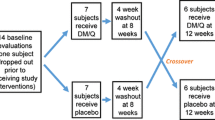Abstract
In autism, glutamate may be increased or its receptors up-regulated as part of an excitotoxic process that damages neural networks and subsequently contributes to behavioral and cognitive deficits seen in the disorder. This was a double-blind, placebo-controlled, parallel group study of lamotrigine, an agent that modulates glutamate release. Twenty-eight children (27 boys) ages 3 to 11 years (M = 5.8) with a primary diagnosis of autistic disorder received either placebo or lamotrigine twice daily. In children on lamotrigine, the drug was titrated upward over 8 weeks to reach a mean maintenance dose of 5.0 mg/kg per day. This dose was then maintained for 4 weeks. Following maintenance evaluations, the drug was tapered down over 2 weeks. The trial ended with a 4-week drug-free period. Outcome measures included improvements in severity and behavioral features of autistic disorder (stereotypies, lethargy, irritability, hyperactivity, emotional reciprocity, sharing pleasures) and improvements in language and communication, socialization, and daily living skills noted after 12 weeks (the end of a 4-week maintenance phase). We did not find any significant differences in improvements between lamotrigine or placebo groups on the Autism Behavior Checklist, the Aberrant Behavior Checklist, the Vineland Adaptive Behavior scales, the PL-ADOS, or the CARS. Parent rating scales showed marked improvements, presumably due to expectations of benefits.
Similar content being viewed by others
REFERENCES
Aman, M. G., Singh, N. N., Stewart A.W., & Field, C. J. (1985). The aberrant behavior checklist: a behavior rating scale for the assessment of treatment effects. American Journal of Mental Deficiency, 89(5), 485-491.
Bauman, M. L., and Kemper, T. L. (1984). Neuroanatomic observations of the brain in autism. In M. L. Bauman, & T. L. Kemper (Eds.), The neurobiology of autism (pp. 119-145). Baltimore: The Johns Hopkins University Press.
Bittigau, P., & Ikonomidou, C. (1997). Glutamate in neurologic diseases. Journal of Child Neurology, 12, 471-485.
Brodie, M. (1992). Lamotrigine. Lancet, 339, 1397-1400.
Buoni, S., Grosso, S., & Fois, A. (1998). Lamotrigine treatment in childhood drug resistant epilepsy. Journal of Child Neurology, 13, 163-167.
Coulter, D. A. (1997). Antiepileptic drug cellular mechanisms of action: where does lamotrigine fit in? Journal of Child Neurology, 12(Suppl. 1), S2-9.
Delong, R. (1994). Children with autistic spectrum disorder and a family history of affective disorder. Developmental Medicine and Child Neurology, 36, 659-660.
DiLavore, P. C., Lord, C., & Rutter, M. (1995). The pre-linguistic autism diagnostic observation schedule. Journal of Autism and Developmental Disorders, 25(4), 355-379.
Herrling, P. L. (ed.). (1997). Excitatory amino acids: clinical results with antagonists. San Diego, CA: Academic Press.
Kornhuber, J., Mack-Burkhardt, F., Konradi, C., Fritze, J., & Riderer, P. (1989). Effect of antemortem and postmortem factors on [3H]MK-801 binding in the human brain: Transient elevation during early childhood. Life Science, 45, 745-749.
Kotler, M., & Matar, M. A. (1998). Lamotrigine in the treatment of resistant bipolar disorder. Clinical Neuropharmacology, 21(1), 65-67.
Krug, D. A., Arick, J., & Almond, P. (1993). Autism Behavior Checklist Record Form. Austin Texas: PRO-ED, Inc.
Lord, C., Rutter, M., Goode, S., Heemsbergen, J., Jordan, H., Mawhood, L., & Schopler, E. (1989). Autism diagnostic observation schedule: a standardized observation of communicative and social behavior. Journal of Autism and Developmental Disorders, 19, 185-212.
Lord, C., Rutter, M., & LeCouteur, A. (1994). Autism diagnostic interview-revised: a revised version of a diagnostic interview for caregivers of individuals with possible pervasive developmental disorders. Journal of Autism and Developmental Disorders, 24, 659-685.
Monaghan, D. T., & Cotman, C. W. (1985). Distribution of NMDA-sensitive L-3H-glutamate binding sites in rat brain as determined by quantitative autoradiography. Journal of Neuroscience, 5, 2909-2919.
Rapin, I., & Katzman, R. (1998). Neurobiology of autism. Annals of Neurology, 43, 7-14.
Raymond, G., Bauman, M., & Kemper, T. L. (1996). Hippocampus in autism: A Golgi analysis. Acta Neuropathologica, 91, 117-119.
Schopler, E., Reichler, R., & Renner, B. (1988). Childhood Autism Rating Scale (CARS). Los Angeles: Western Psychological Services.
Sparrow, S. S., Balla, D. A., & Cicchetti, D. V. (1984). Vineland Adaptive Behavior Scales; Interview Edition Survey Form. Circle Pines, Minnesota: American Guidance Service, Inc.
Sporn, J., & Sachs, G. (1997). The anticonvulsant lamotrigine in treatment-resistent manic-depressive illness. Journal of Clinical Psychopharmacology, 17, 85-89.
Uldall, P., Hansen, F. J., & Tonnby, B. (1993). Lamotrigine in Rett syndrome. Neuropediatrics, 24, 339-340.
Uvebrant, P., & Bauziene, R. (1994). Intractable epilepsy in children. The efficacy of lamotrigine treatment including nonsiezure-related benefits. Neuropediatrics, 25, 284-289.
Author information
Authors and Affiliations
Rights and permissions
About this article
Cite this article
Belsito, K.M., Law, P.A., Kirk, K.S. et al. Lamotrigine Therapy for Autistic Disorder: A Randomized, Double-Blind, Placebo-Controlled Trial. J Autism Dev Disord 31, 175–181 (2001). https://doi.org/10.1023/A:1010799115457
Issue Date:
DOI: https://doi.org/10.1023/A:1010799115457




